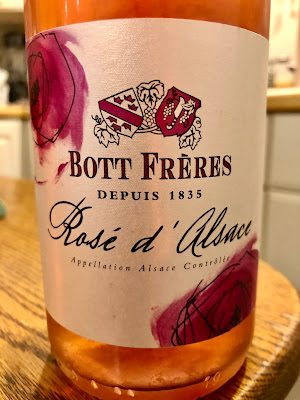With Thanksgiving this week, many people are thinking about which wines to drink with their turkey dinner. It's important to realize that Rosé is not just a summer wine, especially considering how well it pairs with a wide variety of foods. Rosé works well on your Thanksgiving table, and it will pair well with other holiday dishes during the rest of this year.
I love the wines of Alsace, from their Crémant d'Alsace to their intriguing White wines. You might not realize that they make some delicious Red wines too. Pinot Noir is the only authorized grape for AOC Red wines, and that applies to their Rosé wines as well. Unfortunately, very little is currently imported into the U.S. although hopefully that will change.
Within Alsace, Pinot Noir is planted in nearly 11% of their vineyards, and they produce about 105,000 hectoliters of wine with Pinot Noir, which appears to include Crémant d'Alsace, Rosé and Red still wines. Pinot Noir has a lengthy history in the Alsace region, with some claiming it extends back to the ancient Romans. During the 15th and 16th centuries, Alsace Pinot Noir was even more valued than all of their white wines. For unknown reasons, that changed over time so that their wine wines came to dominate.
Within the various terroirs of Alsace, it has been learned that Pinot Noir grows best in their clay and limestone soils, while Pinot Noir grown in more gravel and sandy soils is best suited for use in Crémant d'Alsace and Rosé. In addition, due to climate change, temperatures in Alsace have risen, making it easier to ripen their Pinot Noir. Some of the best areas to grow Pinot Noir are also designated Grand Cru, but only for white wines. Currently, Pinot Noir cannot be designated as Grand Cru though there are efforts to change this and it seems likely that within several years, Grand Cru Pinot Noir will be authorized.
In general, Alsace Pinot Noir tends to present bright red fruit flavors, crisp acidity, and vibrant freshness. Many are intended to be consumed while young though some have the potential for aging. Oak aging is sometimes used, and when it is, it is more of a light touch, allowing the fruit to take center stage. Curiously, their Pinot Noir is usually bottled in "flutes," those bottles you most commonly see used for Riesling.
Within Alsace, Pinot Noir is planted in nearly 11% of their vineyards, and they produce about 105,000 hectoliters of wine with Pinot Noir, which appears to include Crémant d'Alsace, Rosé and Red still wines. Pinot Noir has a lengthy history in the Alsace region, with some claiming it extends back to the ancient Romans. During the 15th and 16th centuries, Alsace Pinot Noir was even more valued than all of their white wines. For unknown reasons, that changed over time so that their wine wines came to dominate.
Within the various terroirs of Alsace, it has been learned that Pinot Noir grows best in their clay and limestone soils, while Pinot Noir grown in more gravel and sandy soils is best suited for use in Crémant d'Alsace and Rosé. In addition, due to climate change, temperatures in Alsace have risen, making it easier to ripen their Pinot Noir. Some of the best areas to grow Pinot Noir are also designated Grand Cru, but only for white wines. Currently, Pinot Noir cannot be designated as Grand Cru though there are efforts to change this and it seems likely that within several years, Grand Cru Pinot Noir will be authorized.
In general, Alsace Pinot Noir tends to present bright red fruit flavors, crisp acidity, and vibrant freshness. Many are intended to be consumed while young though some have the potential for aging. Oak aging is sometimes used, and when it is, it is more of a light touch, allowing the fruit to take center stage. Curiously, their Pinot Noir is usually bottled in "flutes," those bottles you most commonly see used for Riesling.
The Bott Frères winery was founded in 1835 by Philippe Louis Bott, the son of a brewer and an winegrower. It's primarily located in Ribeauvillé, an old medieval town known for the ruins of three fortified castles. The winery currently has about 50 acres of vineyards, sustainably farmed (and moving towards organic), and produces only about 15,000 cases of wine annually.
The 2020 Bott Frères Rosé d'Alsace ($20) is made from 100% Pinot Noir, from 20 year old vines in chalky soil, and was aged in stainless steel tanks for about 8-10 months. With a 14% ABV, the wine has a rich pink color and an appealing aroma of fresh red berries and floral notes. On the palate, it's fresh and crisp, with tasty red fruit flavors, especially raspberry and strawberry, with a floral accent, and a nice streak of minerality. Well balanced, complex, and with a lengthy finish, this Rosé is absolutely delicious, perfect on its own or paired with food. This is an excellent holiday wine which will impress your guests.

No comments:
Post a Comment